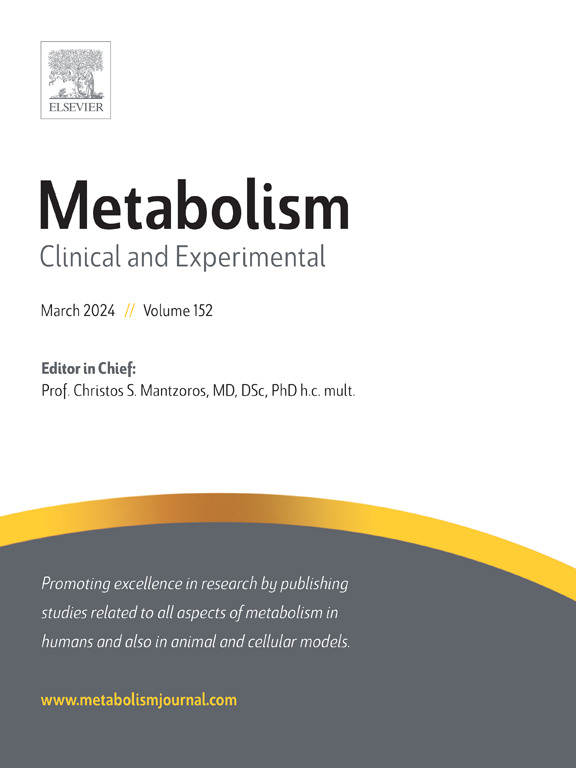A partial loss-of-function variant (Ile191Val) of the TAS1R2 glucose receptor is associated with enhanced responses to exercise training in older adults with obesity: A translational study
IF 10.8
1区 医学
Q1 ENDOCRINOLOGY & METABOLISM
引用次数: 0
Abstract
Background
The TAS1R2 receptor, known for its role in taste perception, has also emerged as a key regulator of muscle physiology. Previous studies have shown that genetic ablation of TAS1R2 in mice enhances muscle fitness mimicking responses to endurance exercise training. However, the translational relevance of these findings to humans remains uncertain.
Methods
We explored responses to endurance exercise training in mice and humans with genetic deficiency of TAS1R2. First, we assessed the effects of muscle-specific deletion of TAS1R2 in mice (mKO) or wild type controls (mWT) following 4 weeks of voluntary wheel running (VWR). Next, we investigated the effects of the TAS1R2-Ile191Val (rs35874116) partial loss-of-function variant on responses to a 6-month diet-induced weight loss with exercise training (WLEX), weight loss alone (WL), or education control (CON) interventions in older individuals with obesity. Participants were retrospectively genotyped for the TAS1R2-Ile191Val polymorphism and classified as conventional function (Ile/Ile) or partial loss-of-function (Val carriers: Ile/Val and Val/Val). Body composition, cardiorespiratory fitness, and skeletal muscle mitochondrial function were assessed before and after the intervention.
Results
In response to VWR, mKO mice demonstrated enhanced running endurance and mitochondrial protein content. Similarly, TAS1R2 Val carriers exhibited distinctive improvements in body composition, including increased muscle mass, along with enhanced cardiorespiratory fitness and mitochondrial function in skeletal muscle following the WLEX intervention compared to Ile/Ile counterparts. Notably, every Val carrier demonstrated substantial responses to exercise training and weight loss, surpassing all Ile/Ile participants in overall performance metrics.
Conclusions
Our findings suggest that TAS1R2 partial loss-of-function confers beneficial effects on muscle function and metabolism in humans in response to exercise training, akin to observations in TAS1R2 muscle-deficient mice. Targeting TAS1R2 may help enhancing exercise training adaptations in individuals with compromised exercise tolerance or metabolic disorders, presenting a potential avenue for personalized exercise interventions.
TAS1R2葡萄糖受体的部分功能缺失变体(Ile191Val)与肥胖症老年人对运动训练的反应增强有关:一项转化研究。
背景:TAS1R2 受体因其在味觉感知中的作用而闻名,它也已成为肌肉生理的一个关键调节因子。先前的研究表明,在小鼠体内对 TAS1R2 进行基因消减,可增强肌肉体能,模拟对耐力运动训练的反应。然而,这些发现对人类的转化意义仍不确定:方法:我们研究了基因缺乏 TAS1R2 的小鼠和人类对耐力运动训练的反应。首先,我们评估了肌肉特异性缺失 TAS1R2 的小鼠(mKO)或野生型对照组(mWT)在 4 周自愿轮跑(VWR)后的影响。接下来,我们研究了 TAS1R2-Ile191Val (rs35874116) 部分功能缺失变异对老年肥胖症患者进行为期 6 个月的饮食诱导减肥与运动训练 (WLEX)、单纯减肥 (WL) 或教育控制 (CON) 干预的影响。研究人员对参与者进行了TAS1R2-Ile191Val多态性基因分型,并将其分为传统功能型(Ile/Ile)或部分功能缺失型(Val携带者:Ile/Val和Val/Val)。干预前后对身体成分、心肺功能和骨骼肌线粒体功能进行了评估:结果:针对 VWR,mKO 小鼠的跑步耐力和线粒体蛋白含量均有所提高。同样,TAS1R2 Val 基因携带者与 Ile/Ile 基因携带者相比,在接受 WLEX 干预后,身体成分有明显改善,包括肌肉质量增加,心肺功能和骨骼肌线粒体功能增强。值得注意的是,每个 Val 基因携带者都对运动训练和体重减轻表现出实质性的反应,在总体表现指标上超过了所有 Ile/Ile 参与者:我们的研究结果表明,TAS1R2部分功能缺失会对人类的肌肉功能和新陈代谢产生有益影响,从而对运动训练做出反应,这与在TAS1R2肌肉缺陷小鼠身上观察到的结果类似。以TAS1R2为靶标可能有助于增强运动耐受性受损或代谢紊乱个体的运动训练适应性,为个性化运动干预提供了潜在的途径。
本文章由计算机程序翻译,如有差异,请以英文原文为准。
求助全文
约1分钟内获得全文
求助全文
来源期刊

Metabolism: clinical and experimental
医学-内分泌学与代谢
CiteScore
18.90
自引率
3.10%
发文量
310
审稿时长
16 days
期刊介绍:
Metabolism upholds research excellence by disseminating high-quality original research, reviews, editorials, and commentaries covering all facets of human metabolism.
Consideration for publication in Metabolism extends to studies in humans, animal, and cellular models, with a particular emphasis on work demonstrating strong translational potential.
The journal addresses a range of topics, including:
- Energy Expenditure and Obesity
- Metabolic Syndrome, Prediabetes, and Diabetes
- Nutrition, Exercise, and the Environment
- Genetics and Genomics, Proteomics, and Metabolomics
- Carbohydrate, Lipid, and Protein Metabolism
- Endocrinology and Hypertension
- Mineral and Bone Metabolism
- Cardiovascular Diseases and Malignancies
- Inflammation in metabolism and immunometabolism
 求助内容:
求助内容: 应助结果提醒方式:
应助结果提醒方式:


